
The Changing Landscape of Massillon Football – Part 2: Defensive Formations
This is the second of a 7-part series, which includes the following installments:
- Part 1: Offensive Formations
- Part 2: Defensive Formations
- Part 3: Passing Frequency
- Part 4: Scheduling
- Part 5: Roster Size
- Part 6: Stadiums
- Part 7: Game Attendance
Just as offensive formations have evolved throughout the years, so have defensive formations. Call it a case of the ever-improving designs of guns and armor, as these two concepts have literally chased each other forever. And they’ve chased each other in football as well. In the years prior to the spread offense, Massillon’s defenses held opponents to an average of seven points per game. However, during the 25+ years of spread offense, the defensive output has risen to 18 points per game. Such is the impact of the spread. We live in a different world today!
Part 2 of this series presents the defensive formations used by various Massillon coaches from Paul Brown to the present time, with additional discussion of Nate Moore’s Fusion Defense.
Defending the Single-Wing
Once the sport got mass formations out of its system through a series of rule changes (settling on a 7-man line, introducing the passing game, etc.), it was time to get down to serious business of playing football. What came out of this was the Single-Wing offense, which was designed to trick the defense, rather than overpower it. Although the pass had been permitted as part of the game for over twenty years by the time Paul Brown arrived in Massillon, it was little-used, as it was effective only around 40% of the time. Therefore, defenses at that time were focused primarily on stopping the run, while giving modest respect to the pass. Anywhere from six to eight defenders were positioned on the line, with the remaining players behind. The chart below shows how Brown defended Canton McKinley’s single-wing offense in 1940, using a 6-man front, 3 linebackers and 2 safeties. Note the overload of defenders on the side of the ball opposite the wingback. In the Bulldogs’ single-wing offense, a pass play would involve the wingback as a receiver and normally flow to that side of the ball. However, most running plays flowed to the opposite side, with the wingback often in motion prior to the play. It was all about the numbers for Brown and the ability to match or outnumber the offense at the point of attack. So in essence, Brown geared his defense to stop the run first, particularly around the end.
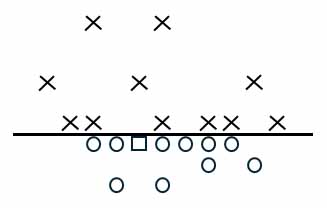
Thirteen years later, with Chuck Mather as the head coach, Massillon also employed a 6-man line. But as a change from Brown, he placed his linemen evenly across the line, since opponents were beginning to run more up the middle. He also backed up the line with four linebackers and a single safety. Below is his formation against McKinley in 1953.
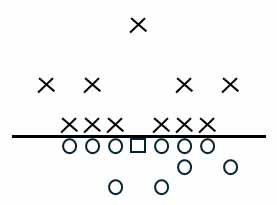
Defending the Wing-T, the Full House-T, the Power-I and any other run-oriented offense
Eventually, the Single-Wing was replaced by the Wing-T. Coach Lee Tressel defended the Wing-T with a run-stopping 6-man front. He called it “62 Games.” But it was a hybrid of the 5-man to front to come in that a pre-selected lineman would drop back on each play, providing some confusion to the offense, while also providing some additional pass support. The formation Tressel used against Canton McKinley in the 1957 game is shown below.
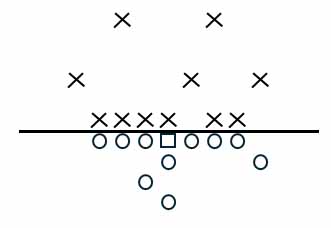
As passing performances finally began to improve, it was Leo Strang in 1958 that changed from a 6-man to a 5-man defensive front. And that 5-man configuration was maintained within the Massillon program for the next 40+ years, until the time of the spread offense. It was derived from the “5-2 Oklahoma,” which was developed by Coach Bud Wilkinson in 1949, and featured a linebacker over each guard. By positioning the linebackers as such (as opposed to the earlier 5-2 Eagle, which positioned the linebackers over the tackles and ends), the formation allowed them to key on the movements of the guards, thereby providing better support over the middle. Completing the formation were four defensive backs, one of which often referred to as the “monster back.” He normally provided an additional defender on the wide side of the field. Below is a typical formation used by Massillon.
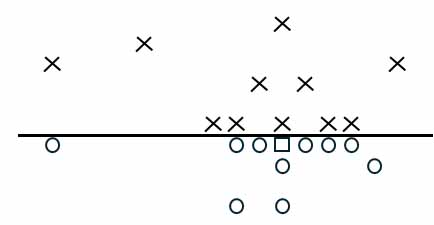
Defending the Spread Offense
The spread offense was revolutionary and changed everything in regard to defensive formations. While Tiger Coach Rick Shepas brought the offense to Massillon in 1998, it was Cleveland St. Ignatius that in earlier years put it on display on the opposite side of the ball, forcing the Tigers to figure out how to defend it. Suddenly, the 5-man defensive front became obsolete. The Wildcats would often place three wide receivers to one side of the ball. The furthest one would be covered by the cornerback. And the next receiver in would be covered by the monster back. But the inner-most one would demand coverage by the defensive end, who was forced to abandon his assigned position on the line. Unfortunately, this resulted in a mismatch in that a defensive end was just not equipped athletically to cover a much faster receiver. Eventually, the Tigers changed to a 4-man front (even front), with an outside linebacker added to the mix. And then a 3-man (odd front) with a second outside linebacker was utilized as defenses were now challenged to defend the entire field. The monster back position was also abandoned in favor of two safeties. The chart below shows a typical defensive alignment against the spread offense.

Massillon, currently integrates both even-front (4-2) and odd-front (3-4) alignments into a scheme Coach Moore refers to as the Fusion Defense. He believes this modern concept is capable of adapting to any kind of offense his team might face throughout the season. However, there is still a degree of game-planning involved, depending on the run/pass ratio the opponent tends to employ. A team that runs the ball a lot may see more 4-2, while a team that passes more may see a heavy dose of 3-4.
Everything that the Tigers do on defense is geared firstly toward toward stopping the run. The goal is to assure that every gap is accounted for, with a concept of plugging the gap and either tackling the runner or spilling him to the outside. It starts with the inside linebackers, whose responsibilities it is to properly read the initial movements of the guards and respond accordingly. How they respond is the unique feature of the Fusion Defense.
Linemen are positioned to play defenders straight up or shade to either side, depending on the call. Meanwhile, the secondary and outside linebackers are tasked with properly aligning to any receiver formation. Pass defenders, just like inside linebackers, must read keys. For example, in defending a formation that has two receivers on one side of the ball, the cornerback aligns over the outside receiver and the safety aligns over the inside receiver. Both key on the inside receiver. If the inside receiver cuts his route inside of six yards, then either the cornerback or the inside linebacker picks him up (depending on the route) and the safety picks up the outside receiver. If he goes beyond six yards, then the cornerback and safety stay with the receivers over which they initially aligned.
Defense of the spread offense went through a painful learning curve in its earlier years and needed to evolve in its own right. With fewer defenders in the box now as compared to previous years owing to the increased challenges of covering multiple receivers, the edges of the formation suddenly became vulnerable to the run. Again, it’s all about the numbers. So, a change in player responsibilities was required. In this case, at least for Massillon, the two safeties are now incorporated into run defense to a greater extent, particularly at the edges of the formation. But the change also creates some risk against the pass as defenders may often be left on their own to cover deep receivers. There is no perfect defense; only those that manage risk effectively. Nevertheless, this modification coupled with incorporation of the Fusion Defense has had a remarkable impact on the Tigers’ ability over the past five years to control the run, as shown in the graph below. While for many years Massillon surrendered around four to five yards per run against the spread offense, they over the past years have surrendered just two to three yards per run. (For additional background on Massillon’s Fusion Defense readers are referred to several YouTube videos that Coach Nate Moore has posted. These videos are highly recommended to Tiger football fans. Search on Nate Moore Fusion Defense.)
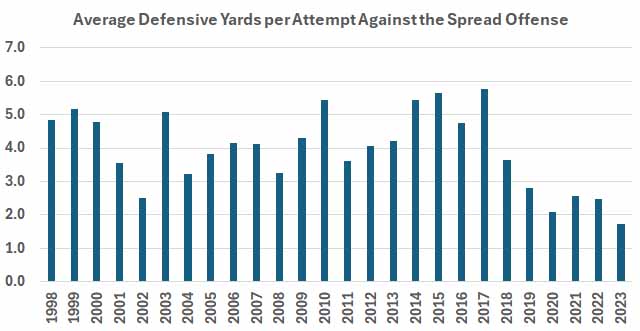
Although the spread offense will continue to evolve, it is difficult to image a new offense replacing it anytime soon, given its greatly enhanced point production. But, perhaps there is a new football world to come.
